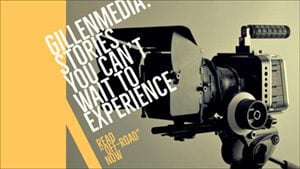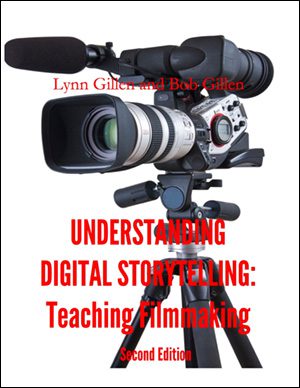FILMMAKERS GLOBAL NETWORK
Community Spotlight
Bob Gillen
Writer, Book Author
CURRENT PROJECTS:

In Off-Road, the teens find themselves in the Mojave Desert filming an off-road race event. A group of over-zealous environmental protestors sabotage their film shoot and the race, all in the name of saving the desert tortoise. Off-Road began as a treatment my wife and I wrote titled, Off-Road Medic. It sat for a while, till I re-worked it as the current book.
Surfrider will find the teens at Malibu, with toxic spills, a panga drug-smuggling boat, and even murder. Again, they’ll use cameras and other gear to get themselves into and out of trouble.

Our students used both skills and instincts to create wonderful film projects. One team produced their own music video of the Marky Mark’s Good Vibrations video. Another team wrote and produced a western parody, shot at the famed Paramount Ranch western set. They wrote their own score using GarageBand.
In all of my writing I add elements of filmmaking and storytelling. Lots of stories feature characters who find themselves through music, sketching, dance, writing. So, few use filmmaking as a means of character development. I want to change that with my books. Young people can express themselves, discover their voices, find a place in this world, through film and story.
WRITING PROCESS:
Sitting in front of a blank computer screen, waiting for a story to take shape – it’s the caricature of every writer. I am no exception. The first draft is hell.
I need structure. I only discovered this several years ago. I’ve written non-fiction for years, and never had trouble with content. I’ve done over 60 interviews with filmmakers and storytellers for my website and blog. The words always came easily. I wrote and published to Amazon several ebooks for educators who teach media production. It was easy to format the books and write the content.
Recently I tried my hand at fiction. A whole other story.
In the last two years I have completed several online MOOC (Massive Open Online Courses) fiction courses from the International Writing Program (IWP) at the University of Iowa. The format pushed me to write, to submit for critique, to learn from others. It was an excellent experience. Several of us fellow participants from the course are putting together our own writing group to continue our writing development.
I participated in NaNoWriMo for the first time last November. The structure of daily word-count quotas gave me the opportunity to finish the first draft of Surfrider. I’m not sure I would do NaNoWriMo again, but it was helpful.
I now use the course outline structure from the IWP as a framework for my weekly blog.
(See www.bobgillen.net.) Each week I search out good short fiction from online sources, usually Narrative Magazine. I then add comments, maybe include a podcast link, and then add a writing sample of my own. I call the blog, Mannequin Monday. My theme: dressing the blank form with words, images, texture.
What I find helpful is writing extensive character profiles. For each of my books I write many pages of character backgrounds. Not so much physical descriptions or the usual notes on where they were born, went to school. I make exhaustive notes on who the character is, what she wants, what drives him, her fears, joys.
You can find more on this approach in Elizabeth George’s book, Write Away. And also, The Art of Dramatic Writing, by Lajos Egri. The latter book focuses on playwriting.
CHALLENGE & SOLUTION:
The challenge: a story that I can’t get right. The solution: persistence.
Years ago, as far back as maybe fifteen years, I wrote a story that had been in my head for years before. A young man makes a film in search of knowing his father, deceased when the boy was only two. His mother resists his film. The boy discovers his father’s ex-lover. I was not happy with the book. The story was weak. The characters were not interesting. The plot, the settings – not so bad. I let it sit for a time. Then I re-wrote it as a play. I had interviewed a playwright, Raegan Payne, for my blog. She had described play writing as a “poor man’s format.” In other words, the playwright had only words and an almost bare stage to tell a story. I tried that. I changed the POV character. I showed it to a friend who teaches drama. He walked me through the problems and weak points. Too many “leaps.” Events that should not have occurred. Characters acting out of character. I re-wrote the play. Tightened it up. Put it up on Amazon. And left it alone. As did readers!
Last year I experimented with re-writing one of the play scenes from a different POV, this time first-person. I always write in third-person. I did this for an assignment in an IWP course. The feedback was good. I think it got better.
Now I am re-writing the story as a novel once more. I’m still not satisfied. The ex-lover character isn’t real enough yet. I have written this character profile over and over. Changed the character’s career. Moved the character around the country.
Persistence. I will keep at it till I think it works. At heart I think it’s a good story. I won’t abandon it.
STORYTELLING TIPS:
I’ve got a few well-used storytelling tips I can share with you.
First – add detail to your writing. This tip comes from author and writing coach, Natalie Goldberg. She urges writers to drill down for lots of detail. Here’s an example. In a desert scene, you could simply say, “(The character) drove up in his pickup truck.” Or you could add details which would make the scene jump off the page. “(The character) drove up in his red Ford F-150, the paint bleached by the sun, mud caked on the tires and wheel wells.” The added detail paints a vivid picture of a well-worn truck, the kind of truck you would expect to see in a desert setting. A truck that matches its driver.
Second – I often use “clustering” to kickstart my writing sessions. This comes from Gabriele Rico’s book, Writing the Natural Way. The technique is quite basic. In the middle of a blank page, write a word and circle it. Perhaps you want to write about a man waiting for a woman at the beach. Someone he hopes he can build a relationship with. Try writing the word “beach” in the center of the page. For ten minutes, write and circle any words that come to mind.
A Long Island beach. A ferry terminal. The woman is late. Maybe it’s raining. The man grows despondent. All around him people are pouring off the ferry. Families. Friends. A Friday afternoon, start of the weekend. He bought her an ice cream cone. It melts down his arm… Continue jotting down whatever comes to mind. After ten minutes you will almost always find a direction for your writing. Then continue writing for another period following the direction you found. In this example, maybe you want to write about the ferry. Something happens there. Someone meets. Someone falls overboard. A passenger gets an emergency text. Nowhere to go. Stuck on the ferry.
I think you get the point. It’s a word exercise to spark a direction for you. You could also use an image or an object in place of a single word. I recently found a picture on Pinterest of a pizza place at a beach town. I built a short story around what I imagined might happen there.
Third – Make use of what literary agent Donald Maass calls “observable actions.” A character is working through their story arc. Events occur. There is an inner journey, of course. But Maass says, observable action is better. I think it could be something as simple as, say, a character sits in a coffee shop, anxious, talking to someone in a tense moment. The character sips an iced tea from a straw. There’s fear in their eyes. A pending difficult decision. We see the character chew the straw flat, full of teeth marks. Run the flattened straw end through their teeth. Let the fear take expression in small actions. Dialogue enhanced by observable actions that support the talk.
I am not doing Maass’s idea justice. I recommend his books on writing. They will force a writer to go deep with a character. Push the writer to throw every imaginable obstacle at the character.



